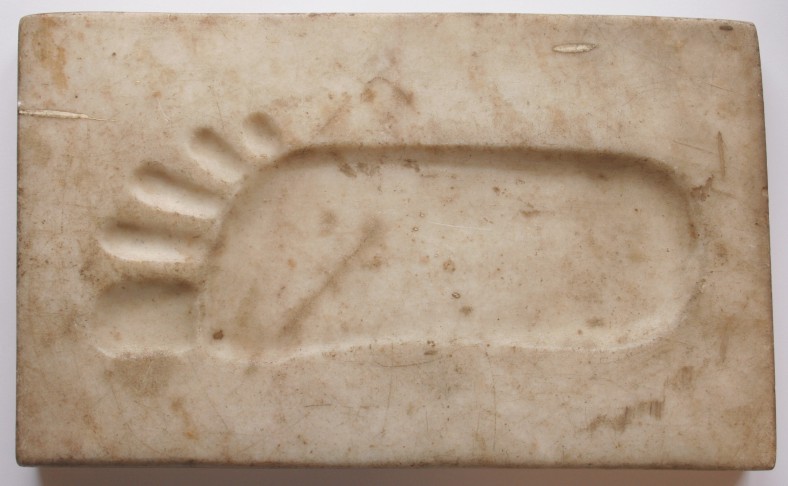EC1307
EC1307 Votive footprint

Marble or travertine slab with foot impression labelled in black ink on the side of the object ‘R. 4473/1936’. The number may indicate that this was part of the Gayer-Anderson collection. The slab measures 34x21x3cm.
This is a low relief of a footprint of a nude right foot. Foot graffiti are found in both Egypt and Nubia, though since it is from the Gayer-Anderson collection it is likely to be Egyptian. Egyptian examples tend to be larger than life size. Some show naked feet or unlaced sandals, or sometimes a combination of both. Sometimes related inscriptions accompany them. They are found in temples, tombs quarries and as desert rock carvings.
Dunand (1979, 63-66) also cites votive footprints in private dwellings dedicated to Isis-Thermouthis at Karanis. Castiglione (1971) sees examples from Egypt as being votive and dating to Graeco-Roman times, though there is evidence that some may be much earlier (Kaper 2009; Shaw 2010, 97). It is often said that the practise of carving votive feet originated in Egypt and was transported to Greece and elsewhere via the Isis cult (Dunand 1973, pl. 17, 1,2; Sackho-Autissier 2006, 260-263) or that of Isis and Serapis (Darnell 2003, 112).
The carving of votive footprints into temple pavements or roof temples was presumably to ensure the donor stayed in the presence of the god (Darnell and Darnell 2002, 121; Jaquet-Gordon 2003, 5; Thissen 1989, 197-198 and Yoyotte 1960, 59-60).
References
Castiglione, L. 1971, ‘Footprints of the Gods in India and in the Hellenistic World; Influence or parallelism?’, Annales Archeologiques Arabes Syrennes 21, 25-37.
Darnell, J.C. 2003. Review of Vahala and Cervicek, Katalog der Feslbilder, in Bibliotheca Orientalis60, 109-115.
Darnell, J.C. in press. Ancient Rock Inscriptions and Graffiti in Shaw, I and Allen, J. eds. The Oxford Handbook of Egyptology. Oxford: Oxford University Press.
Darnell, J.C. and Darnell, D. 2002. Theban Desert Road Survey in the Egyptian Western Desert. Volume 1. Gebel Tjauti Rock Inscriptions 1-45 and Wadi el Hôl Rock Inscriptions 1-45. Oriental Institute Publications vol. 119. Chicago: University of Chicago.
Dunand, F. 1979, Religion Populaire en Egypte Romaine: Les terres cuites Isiaques du Musee du Caire. Leiden: E.J. Brill.
Jaquet-Gordon, H. 2003, The graffiti on the Khonsu Temple Roof at Karnak: A Manifestation of Personal Piety. Oriental Institute Publications vol. 123. Chicago: University of Chicago.
Kaper, OE. 2009, Soldiers Identity Marks of the Old Kingdom in the western desert, in Haring, B.J.J and Kaper, O.E. eds. Pictograms or Pseudo- Script?: Non-textual Identity Marks in Practical Use in Ancient Egypt and Elsewhere. Proceedings of a Conference in Leiden, 19-20th December 2006. Leiden: Peeters, 169-178.
Sackho-Autissier, A. 2006, ‘Quelques remarques sur le bloc Louvre E25562’, RdE 57, 260-263.
Shaw. I. 2010. Hatnub: Quarrying Travertine in Ancient Egypt. London: Egypt Exploration Society.
Thissen, H.-J. 1989. Die Demotischen Graffiti von Medinet Habu. Demotischen Studien 10. Sommerhausen: Gisela Zauzich Verlag.
Yoyotee, J. 1960, Les pèlerinages dans l’Égypte ancienne. In Yoyotee, J. ed. Les Pèlerinages, Sources Oriental. Paris: Éditions du Seuil, 19-74.